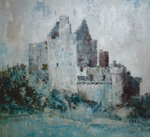Craigmillar's Communiversity presents 'ARTS: THE CATALYST '
Outstanding National Leadership by Example: 1962- 2002
Craigmillar's Communiversity is staging an incredibly powerful Exhibition at the City Art Centre, Market Street, Edinburgh from October 28th to December 31st 2004. It tells the outstanding tale of how Peffermill Mothers' Club created the single most significant initiative in grass roots socioeconomic regeneration Scotland or the UK has ever seen, which survived for forty years only to be closed down then by Edinburgh City Council.
At its peak in 1976 it had 600 employees and 7000 attended the Annual Festival. It won by direct application a massive million euro European Community 'Poverty' Grant. But with the closure [writes its founding inspiration Helen Crummy in the beautiful programme the Exhibition has produced] went the "democratically elected community infrastructure; its sharing, caring and creative philosophy was replaced by market ideology. Remaining projects were made PLCs."
One has to ask Why? And ponder if the same fate awaits all the many Murals Initiatives the Global Association has around the globe. Can initiatives such as Craigmillar be sustained by talented management as Trist [see below] imagines, or can they only flourish when provoked under a leadership that inexorably contains the seeds of its own eventual demise?
But this Exhibition does not ask why. Its purpose is to honour and record the achievements so they can act as benchmarks and inspiration for myriad other grass roots movements.
Click on images to enlarge

Painting by John Prentice
Flash Point Indignation .. that led to Action Learning
The apochraphal [unascribed] response from Peffermill School to its Mothers' Club's request for music lessons that launched the Arts Festival in 1962 was: it takes all our time to teach these children the 3 R's far less music". That was enough; too much. The Mothers' Club decided to go it alone. As Eric Trist, one of Britain's leading post war social psychologists observed in Toronto in 1981: "The Craigmillar folk had not much more than their imagination to fall back on. Their imagination was their open road to greater self reliance. They have used it to the full. ... They are at the leading edge of post-industrial innovation and they have greatly influenced my search for alternatives".
David Harding, Head of Environmetal Art and Sculpture at the Glasgow School of Arts from 1985-2001, writing in the Exhibition Catalogue, observed of Craigmillar's success and its demise:
"Governments never seem to learn.... Scottish Ministers would have achieved more social inclusion if they had taken the two mile trip east to Craigmillar. Here in the sixties and seventies evolved a model for using the arts as a catalyst for social inclusion and progress which gained international fame. It was to here that planners, sociologists, community workers, artists and politicians, along with the great and the good, beat a path from all over the world to witness the miracle, to learn from it and apply it back home".
The Catalogue is a 'MustBuy' and the Exhibition is Not to Be Missed
A brief NewsNet comment here can never do justice to Arts: The Catlayst at Craigmillar. Those of us at work with similarly challenging goals today really must buy the Catalogue and digest the lessons there - and in the excellent bibliography. And if at all possible we must visit the Exhibition before December 31st or attend one of its parallel Workshops and Seminars.
If there is one phrase that sums it all up it is: bottom up not top down. If there is one image to be chosen this reporter would select Gulliver: the Gentle Giant, the 100' play sculpture designed by Jimmy Boyle who wanted to put something back into society. It is the largest concrete sculpture in Europe. It was constructed by an enthusiastic and dedicated Job Creation Team of unemployed young people and adults, with children influencing the design. Instead of a street to play in they now had a safe haven for imaginative play.

Published Date: October 29th 2004
|





